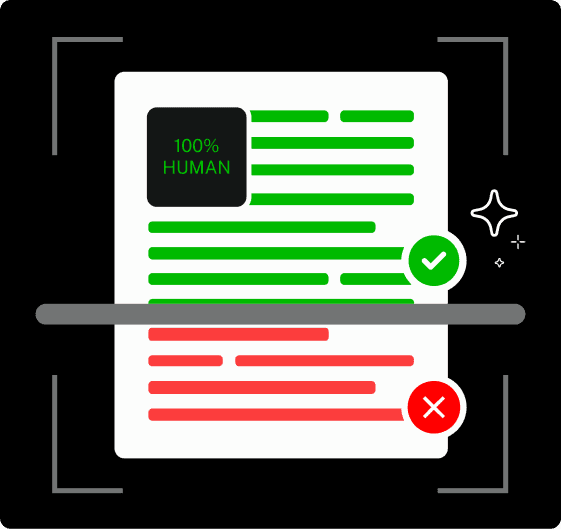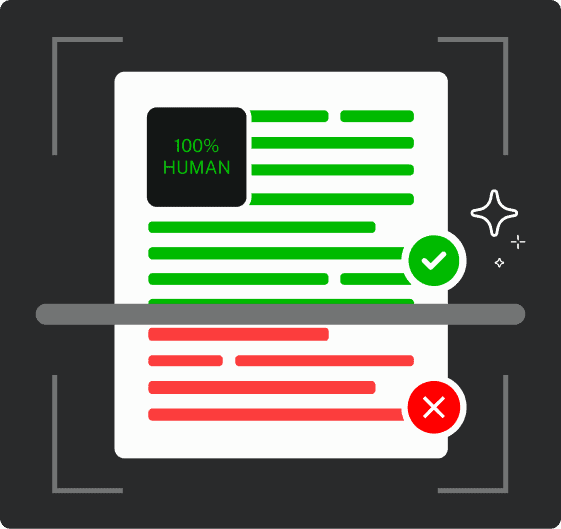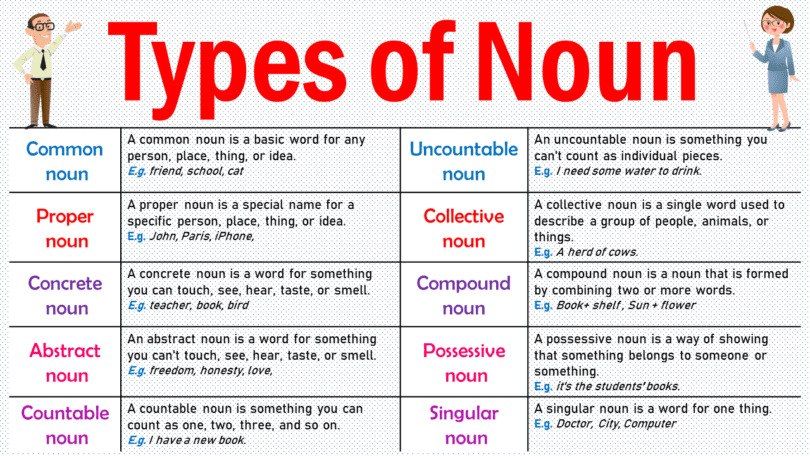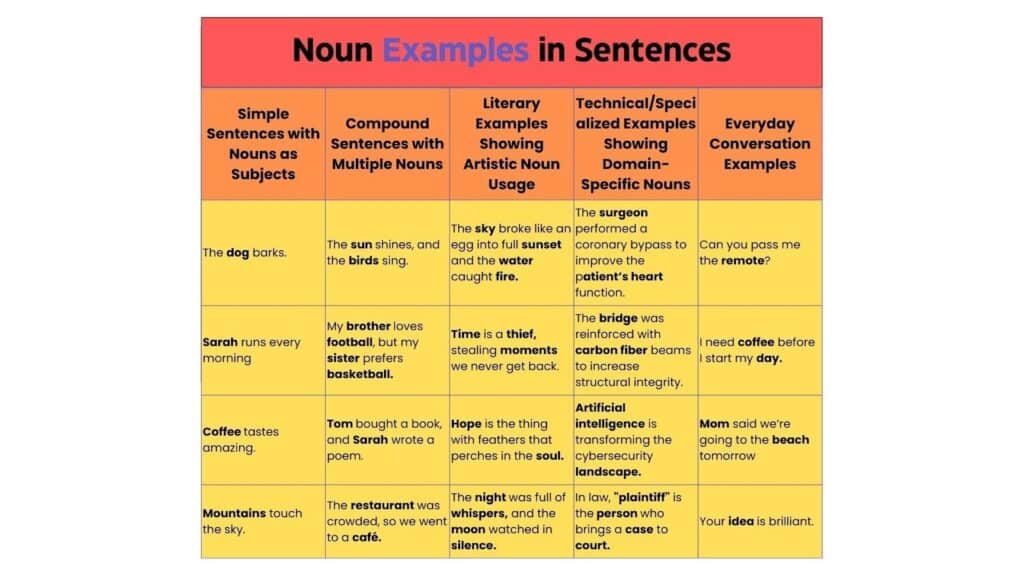Mom, Dad, sister, best friend.. Who’s the most important person in your life?
And what about your favorite things for a second… your phone, your bike, your favorite snack?
The places you love – home, school, the park?
All of these words, the ones we learn as children and use every day, are called nouns.
Nouns are the life of our language. It names the people, places, things, and ideas that populate the world.
In this blog, we’ll explore what a noun is, the six main types of nouns, how to find a noun in sentences, and how to use plural and possessive forms.
We’ll explore everything that will help you understand nouns better. Let’s get started!
What Is a Noun?
The word “noun” comes from the Latin word nomen, which means “name.” A noun is a word that names a person, place, thing, idea, action, or quality.
A noun comes in several different groups:
Person: Barack Obama, a girl, Charlie, dad


Never Worry About AI Detecting Your Texts Again. Undetectable AI Can Help You:
- Make your AI assisted writing appear human-like.
- Bypass all major AI detection tools with just one click.
- Use AI safely and confidently in school and work.
Place: city, Mississippi River, Mount Everest, plaza.
Thing: book, chair, Noor’s bicycle,
Idea: freedom, love, courage, honesty
Action: laughter, movement, dance, jump
Quality: beauty, strength, intelligence, patience
Grammatically, nouns do the heavy lifting in a sentence.
For example,
They can be a subject (The dog barks.), the object (She loves pizza.), or the complement (He is a teacher.).
Without nouns, sentences would be incomplete, awkward, or just plain confusing.
Types of Nouns in English
There are different types of nouns, which are explained here.
- Common Nouns
A common noun is a word for any person, place, or thing – not a specific one. For example,
- city (Common noun) → New York City (Proper noun)
- teacher (Common noun) → Mr. Johnson (Proper noun)
See the difference? Common nouns are general, and they don’t get capitalized in between the sentences, just like proper nouns do. For example,
Correct: I love my dog.
Incorrect: I love my Dog.
But if you name your dog Charlie, now it’s a proper noun and must be capitalized.
- Proper Nouns
Proper nouns are special because they name specific, one-of-a-kind people, places, things, or ideas.
Unlike common nouns that could refer to any person or place, proper nouns point to something unique.
For example,
- country (Common noun) → Japan (Proper noun)
- girl (Common noun) → Olivia (Proper noun)
The rule with proper nouns is that they ALWAYS start with capital letters. For example,
Correct: I visited Paris last summer.
Incorrect: I visited paris last summer.
So you’d write “Mars,” “Tuesday,” “Christmas,” and “Coca-Cola” with capitals.
Sometimes, brands or people choose to break the capitalization rule. For example, iPhone, eBay, or bell hooks. Even then, in formal writing, many style guides still recommend capitalizing them: IPhone, EBay, Bell Hooks etc
- Concrete Nouns
A concrete noun is a noun you can experience with your five senses. If you can see it, hear it, touch it, taste it, or smell it – it’s a concrete noun. For example,
- Dog (you can pet it)
- Music (you can hear it)
- Chocolate (you can taste it)
- Roses (you can smell them)
- Table (you can touch it)
Think of it like this: If you were in a room alone, could you physically sense a thing? If yes, it’s a concrete noun.
- Abstract Nouns
An abstract noun is a noun that names an idea, emotion, quality, or concept – things you can’t experience with your five senses. For example,
- Emotions: Love, happiness, anger
- Qualities: Honesty, bravery, kindness
- States of being: Life, youth, energy
Here’s the thing…
- You can’t SEE happiness, but you can FEEL it.
- You can’t TOUCH justice, but it AFFECTS people’s lives.
- You can’t HEAR bravery, but you KNOW when someone has it.
We can’t physically sense these words, but they describe what’s happening inside us and around us.
Many abstract nouns come from adjectives or verbs. For example,
- Adjective → Abstract Noun
- Kind → Kindness
- Brave → Bravery
- Honest → Honesty
- Verb → Abstract Noun
- Decide → Decision
- Grow → Growth
- Imagine → Imagination
These endings (-ness, -ity, -ion, -ment) often turn regular words into something abstract.
- Collective Nouns
A collective noun is a word that refers to a group of people, animals, or things as one unit.
Even though the group is made up of many members, we treat it as a single thing in a sentence. For example,
- People: A crowd gathered at the concert.
- Things: A collection of stamps filled the album.
So do we use a singular verb or a plural verb with collective nouns?
It’s different everywhere.
- In American English, we usually treat collective nouns as singular. For example,
- The team is playing well.
- The family has arrived.
- In British English, collective nouns are often treated as plural. For example,
- The team are playing well.
- The family have arrived.
It depends on whether we’re thinking of the group as one whole (singular) or many individuals (plural).
Collective nouns make our language more precise. Instead of saying “a lot of birds,” you can say a flock. Instead of “many ships,” you can say a fleet.
- Countable vs. Uncountable Nouns
Countable Nouns
They are things you can count (1, 2, 3…). They have singular and plural forms. For example,
- I ate an apple.
- She has three books.
We use a/an in singular form and some/many/few in plural form. For example,
- A dog is barking.
- She has many books.
Uncountable Nouns
They are things you cannot count individually because they are often liquids, ideas, or abstract concepts. They do not have a plural form. For example,
- I need water. (Not “a water” or “waters”)
- She gave me good advice. (Not “an advice”)
Uncountable nouns do not use a/an because they can’t be counted, but they can use some/little/much. For example,
- Correct: I need some sugar.
- Incorrect: I need sugar.
However, we can use a quantifier for uncountable nouns. For example,
- A piece of advice (not “an advice”)
- A glass of water (not “a water”)
- A loaf of bread (not “a bread”)
Then there come nouns which are both countable and uncountable, and their meaning changes accordingly. For example,
1 – Hair
Uncountable: She has long hair. (General)
Countable: I found a hair in my soup. (One single strand)
2 – Chicken
Uncountable: I love eating chicken. (Food)
Countable: There’s a chicken in the yard. (A living bird)
If you’re still confused, here’s a simple trick for you: If a noun sounds like something you can count, try putting a number in front of it. If it makes sense, it’s countable. If not, it’s uncountable!.
1 chair, 2 chairs → ✅ Countable
1 happiness, 2 happineses → ❌ Uncountable

How to Identify a Noun in a Sentence
- The “Person, Place, Thing, or Idea” Rule
When we first learn about nouns, we hear this simple rule: A noun is a person, place, thing, or idea. For example,
- Person → teacher, doctor, Maria
- Place → school, park, London
- Thing → book, table, phone
If a word fits into one of these categories, it’s a noun. But sometimes, this rule doesn’t quite work. Here’s why:
- Some nouns don’t fit neatly into one category. For example, “Light”
- It’s a thing (a lamp), but also an idea (a concept in physics).
- Some words can be both a noun and something else. For example, “Run”
- As a verb: I run every morning.
- As a noun: She went for a run.
- Not everything we can name is a noun. For example, “Quickly”
- It describes how something happens, but it’s an adverb.
So instead of just using the “Person, Place, Thing, or Idea” rule, we can use other tricks to correctly identify nouns. Ask yourself:
- Can I put “a” or “the” in front of it?
Correct: The book, a car
Incorrect: The happy, a quickly
- Can I count it?
Correct: one apple, two apples
Incorrect: One honesty, two honesties
- Does it act as a subject or object in a sentence?
Correct: The dog barks (Dog = noun, subject)
Incorrect: She loves music. (Music = noun, object)
These three questions will help you identify nouns in a sentence.
- Sentence Structure Clues (Subject/Object/Complement)
If you can figure out where nouns appear and what role they play, spotting them becomes much easier. Let’s break it down.
- Nouns as Subjects
Every complete sentence has a subject – the thing that does something. Most of the time, the subject is a noun.
To find a subject, look at the beginning of a sentence, and ask, “Who or what is doing something?” For example,
- The dog barked loudly. (Who barked? The dog.)
- The mountains look beautiful in winter (What looks beautiful? The mountains.)
The subject of a sentence is almost always a noun or a pronoun.
- Noun as Objects
While subjects do something, objects receive the action. Here are the two types of objects:
- Direct Object → Receives the action directly
- Indirect Object → Answers “to whom” or “for whom” the action is done
For example,
- She kicked the ball. (What did she kick? The ball = Direct Object)
- He gave Lisa a gift. (What did he give? A gift = Direct Object, To whom? Lisa = Indirect Object)
Objects always follow the verb in a sentence.
- Nouns as Complements
Sometimes, a noun completes the sentence by giving extra information about the subject. This is called a complement. The types of complement are:
- Predicate Nominative → A noun that renames the subject after a linking verb (is, was, were, seems, becomes)
- Object Complement → A noun that describes or renames the object.
For example,
- She is a doctor. (Doctor = Predicate Nominative, renames She)
- They elected him president. (President = Object Complement, renames him)
Complements don’t receive action, but they complete the sentence’s meaning.
- Articles & Modifiers That Point to Nouns (a, an, the)
Nouns often come with little “helper words” – a, an, the, this, that, my, your, some, many – which make them easier to spot.
1 – The Definite Article: “The”
“The” is called the definite article because it points to a specific noun – something we already know about. For example,
- The sun is shining (There’s only one sun and everyone knows about it)
- She finished the book you lent her. (It’s a specific book)
- I saw the dog in your yard. (It’s a specific dog, not just any dog)
2 – The Indefinite Articles: “A” and “An”
“A” and “an” are called indefinite articles because they introduce non-specific nouns – any one of something, not a particular one. For example,
- She adopted a cat. (just any cat)
- He bought a sandwich for lunch. (we don’t know which sandwich)
- I need an umbrella. (not a particular one)
Use “a” before words that start with a consonant sound: a car, a house, a teacher.
Use “an” before words that start with a vowel sound: an apple, an hour, an idea.
3 – Demonstrative Adjectives: This, That, These, Those
They point to specific nouns based on distance. For example,
- This book is amazing. (Close by)
- That car is expensive (Far away)
- These shoes are comfortable (Close)
- Those mountains are beautiful (Far)
4 – Possessive Adjectives: My, Your, His, Her, Its, Our, Their
Possessive adjectives show ownership – who the noun belongs to. For example,
- My phone is out of battery.
- Your jacket is on the chair.
- Their house is huge.
5 – Quantifiers
Quantifiers tell us the amount of a noun. For example,
- Some apples are rotten.
- Many students love reading.
- Few people know about this secret.
If you see some, many, few, all, several, most, any, or similar words—expect a noun right after!
Noun Examples in Sentences
Nouns are everywhere in language, whether in simple statements, deep literature, or technical discussions.
But how they show up in a sentence changes everything—sometimes they lead the action, sometimes they receive it, and sometimes they just exist in the background, adding meaning.
Let’s break it down with real examples from different situations.

Plural & Possessive Forms of Nouns
1 – Regular Plural Patterns
Nouns change a lot when we make them plural or show ownership. Most of the time, making a noun plural is easy.
- The basic rule is to add -s or -es.
- Dog → Dogs
- Bus → Buses
- Box → Boxes
- Car → Cars
- For nouns ending in -y
- Change -y to -ies (if there’s a consonant before -y)
- Baby → Babies
- City → Cities
- Change -y to -ies (if there’s a consonant before -y)
- Keep the -y, just add -s (if there’s a vowel before -y)
- Toy → Toys
- Monkey → Monkeys
- For nouns ending in -f or -fe
- Change -f to -ves
- Leaf → Leaves
- Wolf → Wolves
- Change -f to -ves
- Just add -s(for some exceptions)
- Roof → Roofs
- Chef → Chefs
2 – Irregular Plural Patterns
- Some words in English follow no standard rules.
- Man → men
- Foot → feet
- Mouse → mice
- Some words don’t change at all.
- Sheep → sheep
- Deer → deer
- Fish → fish
- Then there are Latin/Greek plural who has entirely different rules.
- Cactus → cacti
- Radius → radii
- Phenomenon → phenomena
3 – Rules for Possessive Apostrophe Placement
- For singular nouns, add -’s
- The boy’s hat
- The cat’s tail
- For plural nouns ending in -s, just add ‘
- The teachers’ lounge
- The dogs’ park
- For irregular plurals (no -s at the end), add -’s
- The children’s toys
- The men’s room
How to Never Get Nouns Wrong Again
Nouns are tricky for beginners, especially when it comes to irregular forms.
Some plurals don’t just take an -s (like cats or books), they completely change (like child → children or mouse → mice). So, how do you remember these?
Memory Hacks for Irregular Nouns
- Group them by patterns. For example, many words ending in -f change to -ves (like leaf → leaves).
- Make fun sentences. For example, One goose, two geese – please don’t confuse these!)
AI to the Rescue
1 – AI Essay Writing Tool
Whether you’re a native English speaker or still learning, writing a good essay can be stressful. With the help of AI Essay Writer, you can organize your thoughts into well-structured paragraphs and fix grammar mistakes.
Here’s how to use it:
- Open AI Essay Writing tool.
- Type your topic and click “Generate”
- Get a well-structured, grammar-perfect essay in seconds.
2 – AI Paraphrasing tool
Sometimes, your sentences make sense, but they don’t sound right. That’s where AI Paraphrase tool comes in. Here’s how to use it:
- Go to the AI Paraphrasing tool.
- Paste your sentence or paragraph.
- Click “Paraphraser” to get a smoother, more natural version.
3 – AI Chat
What if you’re stuck and don’t know whether your noun is countable or uncountable? Or how to form the plural correctly? Just ask AI Chat.
For example,
- Is ‘furniture’ countable or uncountable? How do I use it in a sentence?
- What’s the difference between ‘advice’ and ‘advices’? Which one is correct?
See how our AI Detector and Humanizer work—find them in the widget below!
Conclusion
Nouns rock!
Think about it – every cool thing in your life has a name.
Your bestie, your PlayStation, your bedroom, that chocolate cake in the fridge, even that butterfly feeling in your stomach on the first day of school.
Nouns help us grab onto our world and talk about it.
Just look around your classroom or bedroom right now – can you count the chairs, books, pencils, posters, and electronics? Each noun has its own job.
What’s the weirdest noun in your vocabulary? A narwhal? A didgeridoo? A kumquat? Words are fun!
